
Piedra de nacimiento de marzo: Guía completa + Piedras alternativas
Para los cumpleaños que dan inicio a la primavera, los bebés nacidos en marzo tienen dos piedras de nacimiento oficiales: la aguamarina y la heliotropo, ambas con apariencias contrastantes, pero con una tradición igualmente rica.
El mes de marzo recibe su nombre de Marte, el dios romano de la guerra, porque era cuando los soldados romanos reanudaban las campañas tras su aplazamiento por el invierno. Técnicamente, marzo (o Martius) era el primer mes del calendario romano antes de que se añadieran enero y febrero para una mejor sincronización con el año lunar.
Además de regresar a las batallas, los antiguos también retornaron a la agricultura y los viajes, con el equinoccio de primavera del 20 de marzo (o equinoccio de otoño en el hemisferio sur). Se celebraban numerosos festivales, la mayoría celebrando a Marte o el Año Nuevo.
Hoy, marzo simboliza nuevos comienzos, renacimiento y esperanza en el futuro. Además, el mes celebra la igualdad como el Mes de la Historia de la Mujer, y el Día Internacional de la Mujer el 8.
Una vez establecido el significado de marzo, nos sumergiremos en los significados, la historia y las propiedades de las dos piedras de nacimiento de marzo, la piedra de sangre y la aguamarina .
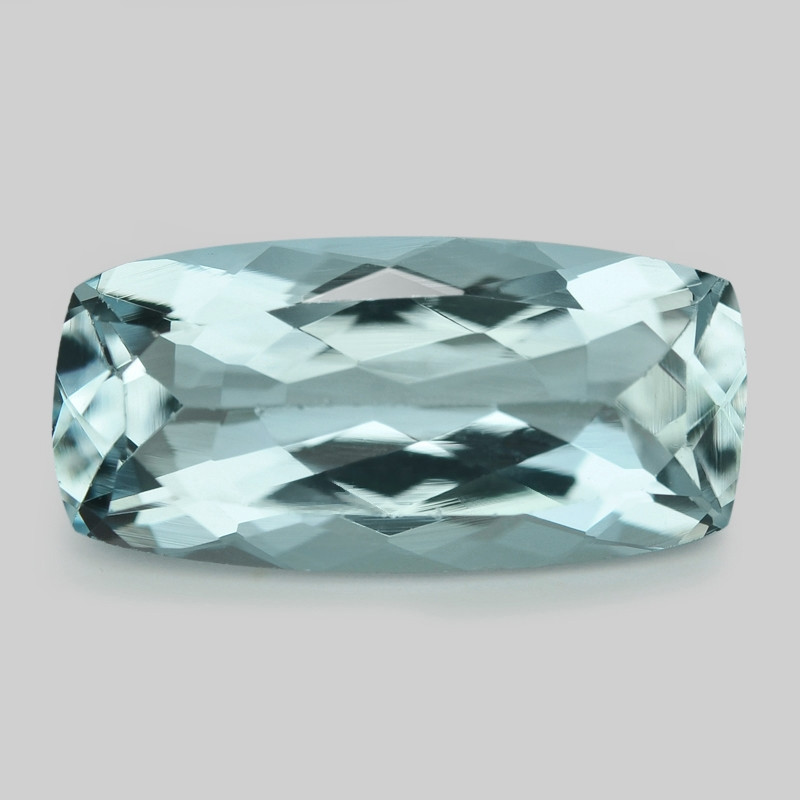
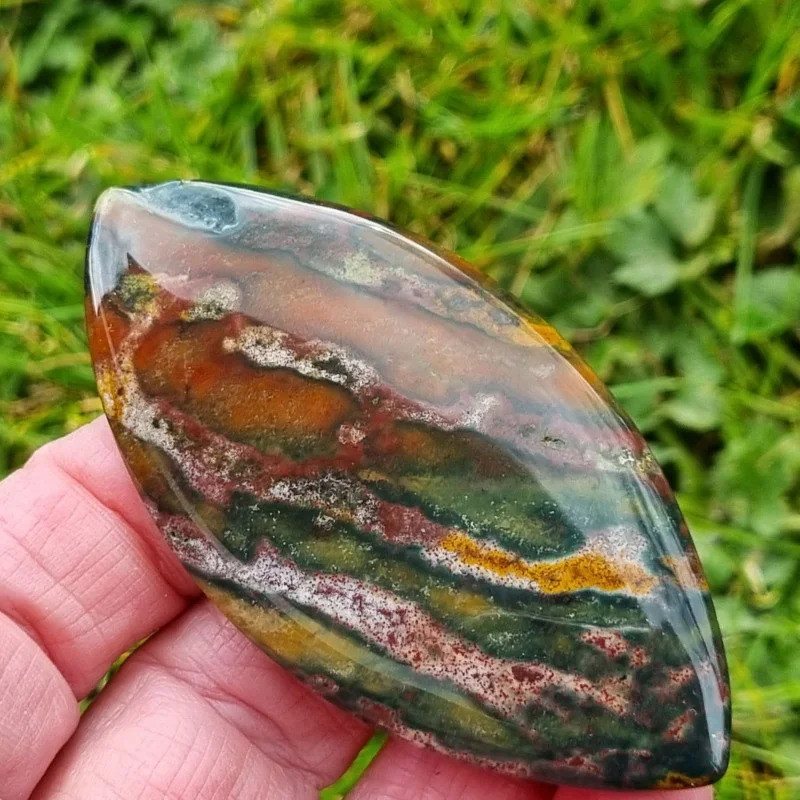 En la imagen de arriba: piedra preciosa aguamarina facetada (arriba), cabujón de piedra de sangre (abajo)
En la imagen de arriba: piedra preciosa aguamarina facetada (arriba), cabujón de piedra de sangre (abajo)
¿Cuáles son las piedras natales de marzo?
Marzo tiene dos piedras de nacimiento tradicionales: la aguamarina y la piedra de sangre. Estas piedras semipreciosas son igualmente legendarias, pero presentan marcados contrastes:
Color : La aguamarina tiene tonos suaves que van del verde mar al azul cielo; la piedra de sangre tiene un color verde bosque profundo con toques carmesí.
Transparencia : Las gemas de aguamarina suelen ser transparentes; las piedras de sangre suelen ser opacas.
Formas de las piedras preciosas : Las aguamarinas suelen estar facetadas ; las piedras de sangre suelen cortarse en cabujones .
Aniversarios de boda : la aguamarina es la gema tradicional del 18.º aniversario de bodas , y la piedra de sangre es una gema alternativa del 14.º aniversario.
Pero ¿por qué hay dos piedras de nacimiento para marzo? En resumen: ¡es histórico!
Orígenes de las piedras natales de marzo
Las tradiciones sobre las piedras de nacimiento se remontan al siglo I d.C. , cuando los historiadores relacionaron listas bíblicas de 12 piedras con los 12 meses del año y los 12 signos del zodíaco.
En las primeras listas de piedras de nacimiento, la piedra de sangre era la única piedra de nacimiento de marzo.
Sin embargo, la identificación precisa de las gemas no se logró durante mucho tiempo, por lo que las piedras reales en los textos antiguos son objeto de debate. Además, la gente no empezó a usar las piedras de nacimiento de su mes de nacimiento hasta que los joyeros de Alemania o Polonia empezaron a vender joyas con piedras de nacimiento alrededor del siglo XVI .
Las listas estandarizadas que conocemos hoy comenzaron alrededor del siglo XIX, cuando Tiffany & Co. publicó poemas sobre piedras de nacimiento en 1870 , atribuidos a un autor gregoriano anónimo.
Aquí está el poema de marzo de ese panfleto:
“Por aquella que en marzo nació
No se debe usar ninguna gema excepto la piedra de sangre
Ellos asegurarán su constancia
“La verdadera amistad y la fidelidad.”
La Asociación Nacional de Joyeros (ahora Joyeros de América) creó una lista estandarizada de piedras de nacimiento en 1912. El Consejo de la Industria Joyera de América actualizó la lista en 1952 y surgieron otras listas (en gran medida similares).
En estas listas, la aguamarina se presentaba como alternativa a la piedra de sangre.
En la actualidad, las listas de piedras de nacimiento británicas y estadounidenses priorizan la aguamarina sobre la piedra de sangre, pero aún incluyen ambas.
Entonces, ¿la piedra de nacimiento de marzo es aguamarina o heliotropo? ¡Ambas! Podría decirse que el heliotropo es la piedra de nacimiento tradicional y la aguamarina, la piedra de nacimiento moderna.
Hablando de tradiciones, veamos la historia de estas dos piedras preciosas.
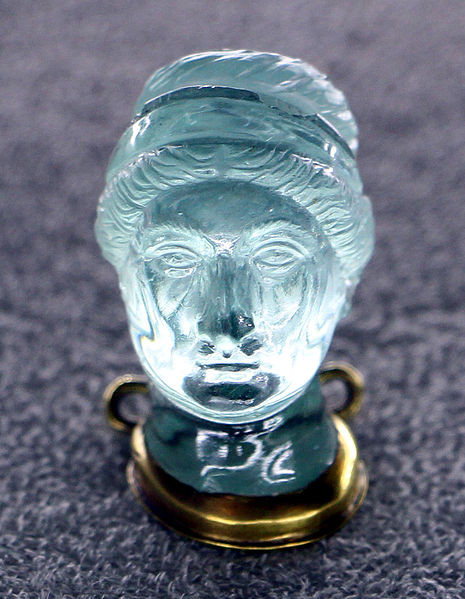 Imagen superior: Arte antiguo, cabeza de una emperatriz en aguamarina, posiblemente Matidia, restaurada en oro en la base; datada en el siglo II (descripción traducida del italiano) | Crédito de la imagen: Sailko, CC-BY-SA-3.0
Imagen superior: Arte antiguo, cabeza de una emperatriz en aguamarina, posiblemente Matidia, restaurada en oro en la base; datada en el siglo II (descripción traducida del italiano) | Crédito de la imagen: Sailko, CC-BY-SA-3.0
Contexto histórico y cultural de las piedras natales de marzo
¡Una cualidad que comparten las dos piedras de nacimiento de marzo es una historia rica y expansiva llena de leyendas y tradiciones!
Usos históricos de la aguamarina
El nombre de aguamarina proviene de los términos latinos aqua , que significa "agua", y marine , que significa "mar", por su parecido con el agua de mar. Aunque este nombre surgió en 1609, el antiguo berilo verde mar se conoció durante siglos.
Los antiguos creían que la piedra de nacimiento de marzo brindaba protección en el mar, y a menudo la tallaban en talismanes. Las leyendas sobre el origen de la aguamarina abarcaban desde ser un tesoro perdido de las sirenas hasta ser creada por el dios del mar Poseidón (o Neptuno).
Muchos antiguos asociaban la aguamarina con la alegría de la juventud y la pasión del amor joven.
Durante la Edad Media , se creía que la aguamarina protegía del envenenamiento (lo que la hizo popular entre la realeza) y facilitaba las habilidades psíquicas.
Los cristianos asociaban la aguamarina con Santo Tomás, patrón de los marineros. Algunos también creían que la gema propiciaba matrimonios felices.
Los budistas también creían que la aguamarina simbolizaba el amor. Una tradición en la India consiste en regalar joyas de aguamarina a los recién casados.
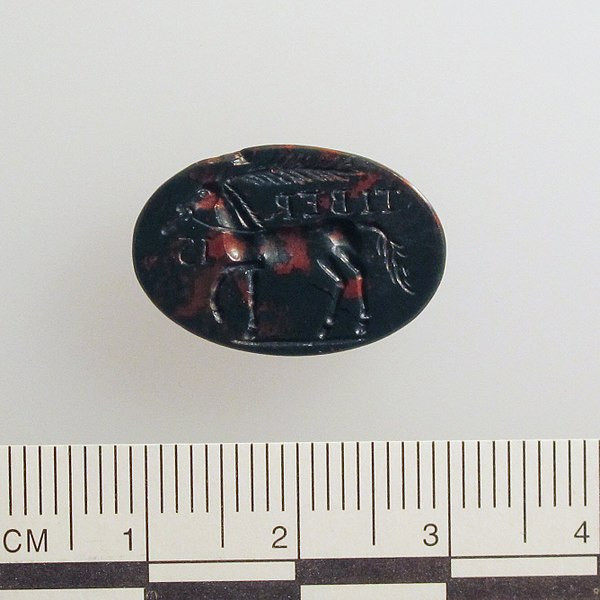 En la imagen superior: Intaglio de heliotropo imperial romano de anguipes con cabeza de gallo (divinidad con serpientes por piernas), datado en el siglo III d. C., exhibido en el Museo Metropolitano de Arte | Crédito de la imagen: Museo Metropolitano, dominio público
En la imagen superior: Intaglio de heliotropo imperial romano de anguipes con cabeza de gallo (divinidad con serpientes por piernas), datado en el siglo III d. C., exhibido en el Museo Metropolitano de Arte | Crédito de la imagen: Museo Metropolitano, dominio público
La piedra de sangre en contextos históricos y místicos
El nombre “piedra de sangre” se refiere a sus patrones típicos de color rojo sangre, en forma de gotas.
Sin embargo, el nombre griego antiguo era “ heliotropo ”, derivado de los términos helios , que significa “sol”, y trepo , que significa “girar”, porque la piedra parecía completamente roja bajo el sol poniente o cuando se colocaba bajo el agua bajo la luz solar directa.
Los antiguos utilizaban la piedra de sangre con fines prácticos y místicos.
Los babilonios crearon sellos de heliotropo, y los nobles usaban anillos de sello de heliotropo para sellar documentos importantes. Los mesopotámicos y babilonios también usaban heliotropo para la adivinación, mientras que egipcios, romanos y griegos creían que la piedra de nacimiento de marzo los hacía más fuertes en la batalla o los deportes.
El erudito romano Plinio el Viejo escribió que las piedras de sangre eran espejos del sol, permitiendo ver eclipses solares. Otro autor romano, Damigerón, escribió que las piedras de sangre predecían el futuro y que, «si se coloca en una palangana de plata llena de agua y se coloca frente al sol, se vuelve hacia él y se vuelve como si estuviera sangrienta y nublada».
Los esclavos liberados solían llevar piedras de sangre grabadas con soles o antorchas para simbolizar su liberación.
Un apodo común era “ piedra del mártir ”, que eventualmente dio lugar al nombre de “piedra de sangre”.
Surgió una leyenda cristiana sobre la piedra de sangre, originada en la crucifixión de Jesucristo. Según la historia, la piedra se formó cuando la sangre de Cristo cayó sobre la tierra verde o sobre un jaspe verde debajo de la cruz (las versiones difieren). Por ello, algunos creían que la piedra curaba problemas circulatorios.
En la Edad Media , la conexión con el mártir persistió con esculturas de piedra de sangre que representaban actos de martirio y amuletos que se creía representaban el sacrificio de Cristo.
Los europeos medievales elaboraban elixires de heliotropo para tratar hemorragias, tumores y mordeduras de serpiente. En la India , el heliotropo en polvo se usaba como afrodisíaco.
Hoy en día, la India es una de las principales fuentes de piedra de sangre, lo que nos lleva a los orígenes de estos cristales de marzo.
 En la imagen de arriba: Aguamarina en bruto
En la imagen de arriba: Aguamarina en bruto
Orígenes geológicos y propiedades de las piedras natales de marzo
La aguamarina es una variedad de berilo. Las piedras de berilo son bastante duraderas, con una dureza de 7,5 a 8 en la escala de Mohs . Estos minerales suelen formarse en pegmatitas de granito que contienen berilo.
Las impurezas presentes determinan la gama de colores, como el hierro ferroso o férrico que subyace a los tonos azul-verdosos de la aguamarina. Por otro lado, los racimos paralelos o perpendiculares de inclusiones tubulares huecas pueden dar lugar a una ligera chatoyancia (efecto "ojo de gato") o asterismo (efecto "estrella"). Algunas de las mejores aguamarinas provienen de Siberia y Brasil.
La piedra de sangre es una variedad de calcedonia o cuarzo microcristalino. Algunos la clasifican como un tipo de jaspe , una subcategoría de la calcedonia para piedras opacas y con dibujos.
La formación de esta piedra natal de marzo es similar a la de otras piedras de cuarzo, pero las manchas rojas provienen de inclusiones de hematita . La mayoría de las piedras de sangre con calidad de gema provienen de la India.
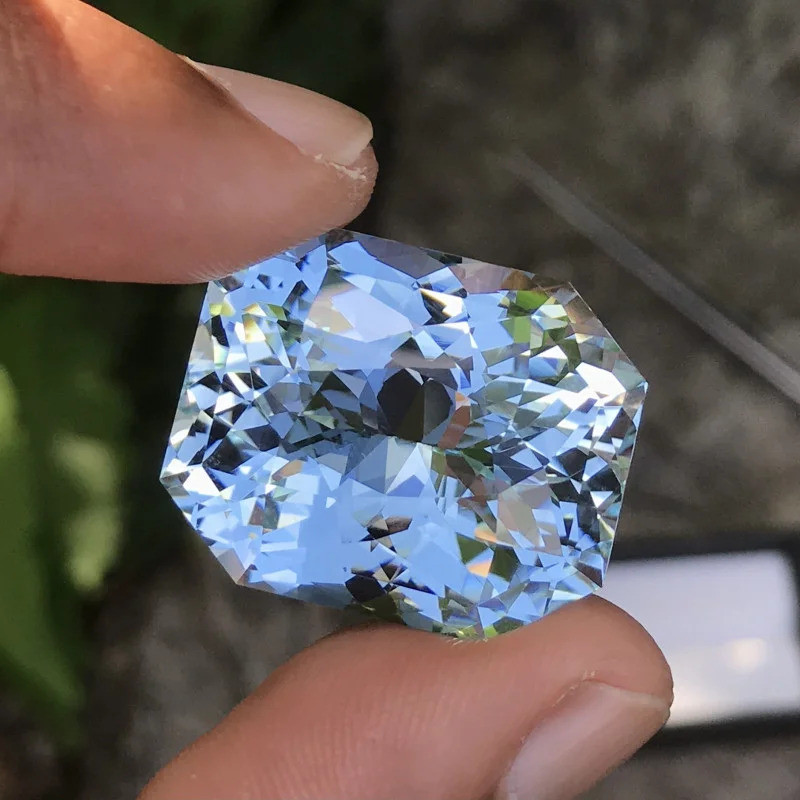 En la imagen de arriba: Aguamarina azul Santa María facetada
En la imagen de arriba: Aguamarina azul Santa María facetada
Tonos de azul y verde: la delicada paleta de aguamarina
A pesar de su rango de colores entre el azul y el verde, la paleta de colores de la aguamarina es sorprendentemente variada. Los valores más altos corresponden a tonos azules más puros y saturados, pero por lo general, los colores de estas piedras natales de marzo son de un azul verdoso pálido.
Ciertos colores tienen nombres comerciales distintos:
Santa Maria : Azul medio oscuro, de alta saturación; Descubierto en la mina Santa Maria de Itabira de Brasil
Espirito Santo : Menor saturación de azul que Santa María, pero brillo único y color profundo.
Maxixe : Color azul muy oscuro; rara vez se encuentra de forma natural en la mina Maxixe de Brasil; generalmente se produce mediante un tratamiento de irradiación inestable (propenso a decolorarse)
Nampula : Azul huevo de petirrojo; se encuentra en la provincia de Nampula, Mozambique.
Pedra Azul : Azul hielo; Se encuentra en el distrito de Pedra Azul de Brasil.
Dado que los colores azules más puros son más valiosos, muchas gemas de aguamarina se tratan térmicamente para eliminar los matices verdes.
Ahora bien, ¿cómo se ve una piedra de sangre?
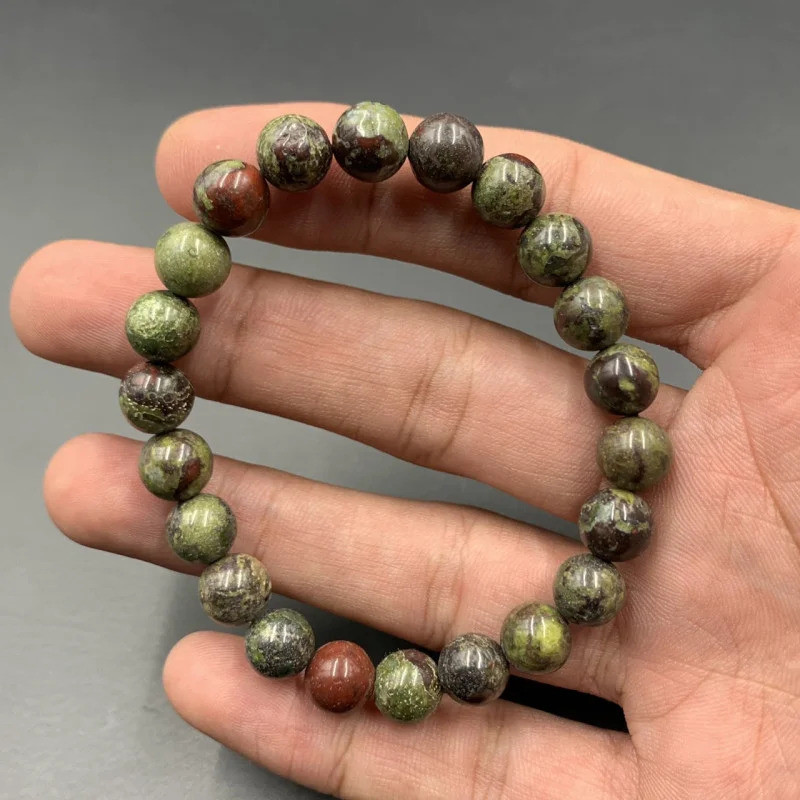
La mística de Bloodstone: motas verdes y rojas profundas
La piedra de sangre se considera técnicamente un tipo de plasma, una variedad de calcedonia verde semitranslúcida a opaca con motas amarillas, blancas o rojas.
La apariencia clásica de la piedra de nacimiento de la piedra de sangre es verde bosque con motas rojas. Las manchas y, a veces, las vetas de la piedra de sangre también pueden ser anaranjadas, marrones, blancas, amarillas o una combinación de estos tonos terrosos.
Además de las inclusiones de hematita roja, otras inclusiones minerales detrás de la coloración de la piedra de sangre incluyen anfíbol, clorita y piroxeno.
Algunos clasifican las piedras de sangre “heliotropo” como translúcidas con motas rojas y las piedras de sangre “plasma” como opacas con muy pocas motas rojas.
Algunas variaciones con nombres comerciales:
Jaspe de sangre : con manchas de color negro rojizo y vetas blancas.
Jaspe de fantasía : Colores predominantes además del verde y el rojo, o combinaciones de colores variadas
Además de las apariencias, otro contraste entre la aguamarina y la piedra de sangre son sus significados espirituales y sus usos como piedras curativas .
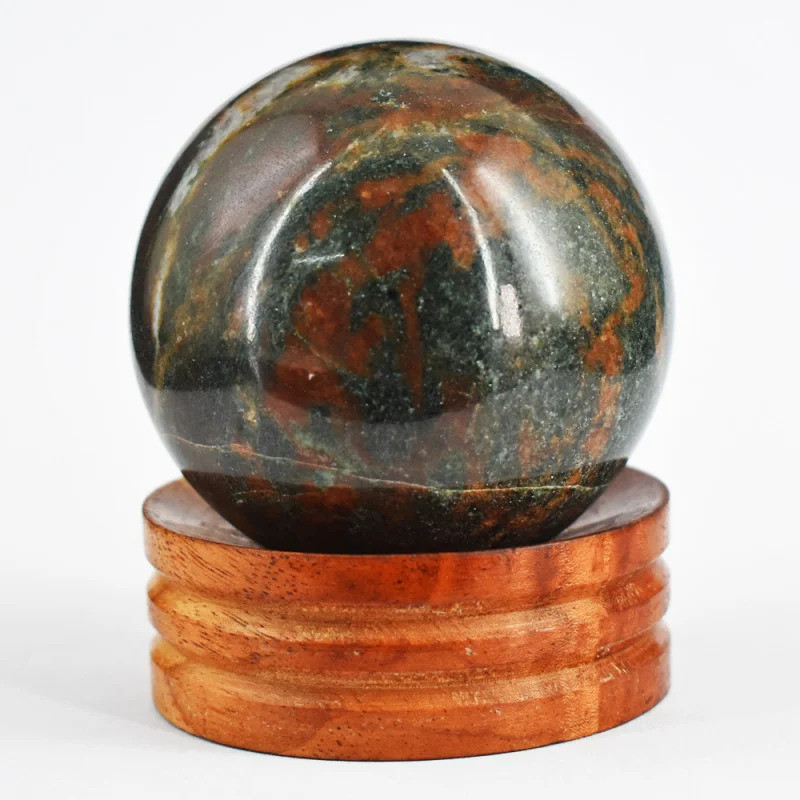 En la imagen de arriba: Bola curativa de piedra de sangre
En la imagen de arriba: Bola curativa de piedra de sangre
Significado espiritual y metafísico
El significado de la piedra de nacimiento aguamarina es de purificación, serenidad y juventud. Por su parte, la piedra de sangre simboliza fuerza, resistencia y sacrificio.
En la curación energética, la aguamarina es una piedra de chakra para el chakra de la garganta, mientras que la piedra de sangre abre el chakra raíz (base).
Sin embargo, algunos de los significados de las piedras natales de marzo se superponen:
Coraje : Se dice que ambas piedras aumentan el coraje, la aguamarina se centra en el autoempoderamiento para decir con valentía tu verdad y la piedra de sangre se centra en el coraje físico para perseguir tus sueños.
Limpieza : Cada piedra puede ofrecer propiedades limpiadoras y purificadoras, eliminando la negatividad y ayudándote a comenzar de nuevo.
Superación de obstáculos : Se cree que la aguamarina ayuda a superar obstáculos emocionales, como la comunicación en una relación. Se dice que la piedra de sangre es protectora y ayuda a superar obstáculos para el éxito.
Astrológicamente, la aguamarina se complementa a la perfección con la sensible energía acuática de Piscis (nacidos del 19 de febrero al 20 de marzo). Por su parte, la piedra de sangre refleja al apasionado y ambicioso Aries (nacidos del 21 de marzo al 19 de abril), regido por Marte.
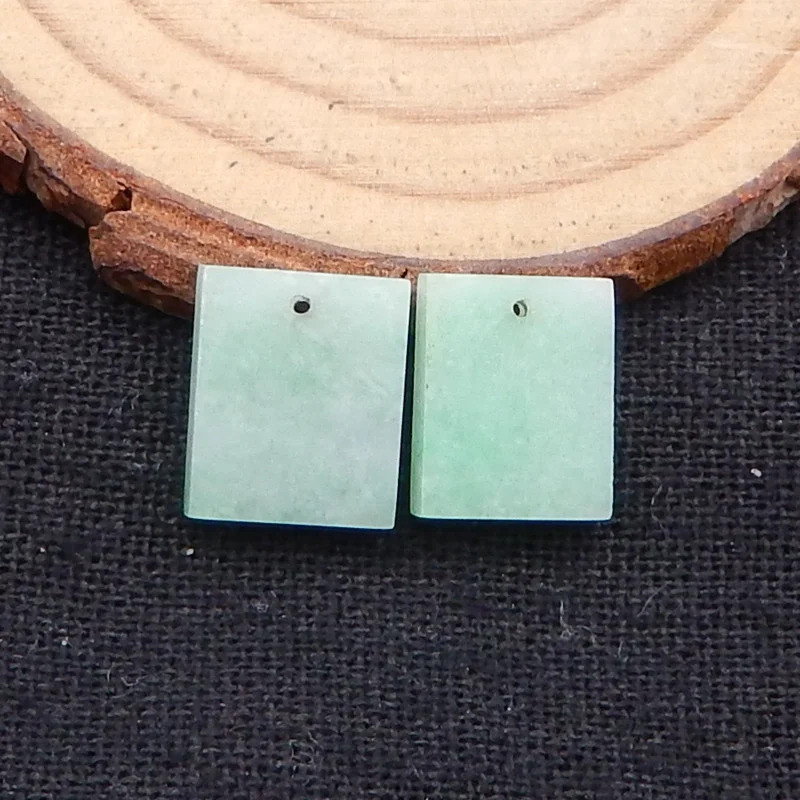 En la imagen de arriba: Pendientes de jade tallado.
En la imagen de arriba: Pendientes de jade tallado.
Explorando piedras natales alternativas de marzo
¿La aguamarina y la heliotropo no te van? ¡Tienes otras opciones!
La mística piedra de nacimiento de marzo, arraigada en la antigua astrología tibetana, es el jade , que captura la dulzura de la primavera con la durabilidad de Marte.
Una segunda piedra de nacimiento alternativa para marzo es el jaspe , similar a la piedra de sangre pero con más variedad.
Otra opción verde es la esmeralda , la piedra de nacimiento de la primavera. La esmeralda, hermana del berilo, tiene un color verde más intenso y también representa el crecimiento de nuevos ejemplares.
En cuanto al precio, la piedra de sangre es mucho más accesible y la aguamarina puede resultar cara para algunos.
Algunas alternativas más asequibles a la piedra de nacimiento aguamarina:
También puedes optar por una aguamarina sintética , que se crea en un laboratorio pero tiene las mismas propiedades químicas y físicas que la aguamarina natural.
 En la imagen superior: la reina Isabel II luciendo su tiara de aguamarina (descrita a continuación) en el Banquete de Estado de Brasil el 7 de marzo de 2006 | Crédito de la imagen: Agência Brasil, CC-BY-SA-3.0 | Archivo original
En la imagen superior: la reina Isabel II luciendo su tiara de aguamarina (descrita a continuación) en el Banquete de Estado de Brasil el 7 de marzo de 2006 | Crédito de la imagen: Agência Brasil, CC-BY-SA-3.0 | Archivo original
Diseños de joyería contemporáneos y famosos
Tanto la aguamarina como la piedra de sangre han aparecido en muchos diseños de joyería únicos en los tiempos modernos.
Aguamarina
Como piedra de nacimiento de marzo o simplemente un hermoso accesorio, las piedras preciosas de aguamarina facetadas brillan con colores suaves pero con un resplandor poderoso.
Los anillos de piedra de nacimiento de aguamarina (o anillos de compromiso) son bastante populares, a menudo colocados junto a piedras de acento blancas o de colores claros como diamantes blancos.
Algunos ejemplos famosos de joyas de aguamarina incluyen:
Tiara de aguamarinas de la reina Isabel : encargada por la reina Isabel de Gran Bretaña en 1957, Garrard creó esta tiara de platino con aguamarinas brasileñas y diamantes que le regaló el presidente brasileño Getúlio Vargas en 1953. El gobernador de Sao Paulo donó una aguamarina más grande para reemplazar la piedra central en 1971.
Colgante de Aguamarina Hirsch : Esta aguamarina de talla esmeralda de 109,92 quilates está engastada en un colgante de oro blanco con 118 diamantes micropavé. Perteneció al emperador francés Luis XV, quien, según se dice, aprovechaba sus propiedades calmantes.
Anillo de compromiso de Meghan Markle : Este anillo de oro amarillo tiene una aguamarina azul claro de 13 quilates de talla esmeralda y diamantes pequeños como acento. El anillo fue fabricado por Asprey y Lucía Flecha de Lima lo regaló a Diana alrededor de 1996. El hijo de Diana, el príncipe Harry, le regaló el anillo a Meghan Markle, quien lo lució el día de su boda en 2018.
Sanguinaria
A diferencia de la aguamarina, la piedra de sangre es una piedra rica, terrosa y pesada con colores que reflejan estos rasgos.
La piedra natal de marzo suele tallarse en cabujones o tallas, por lo que muchas piezas de joyería con heliotropo son colgantes o pulseras de cuentas. Sin embargo, los anillos con heliotropo tallado o encamisado, que evocan estilos antiguos, están ganando popularidad, especialmente en magníficos engastes de oro.
La piedra de sangre no aparece en muchas joyas reales, pero una piedra de sangre real (posiblemente la más famosa) es el sello del emperador del Sacro Imperio Romano Germánico Rodolfo II (1552-1612). Exhibido en el Museo del Louvre de París, el sello del emperador está tallado en esta piedra de sangre.
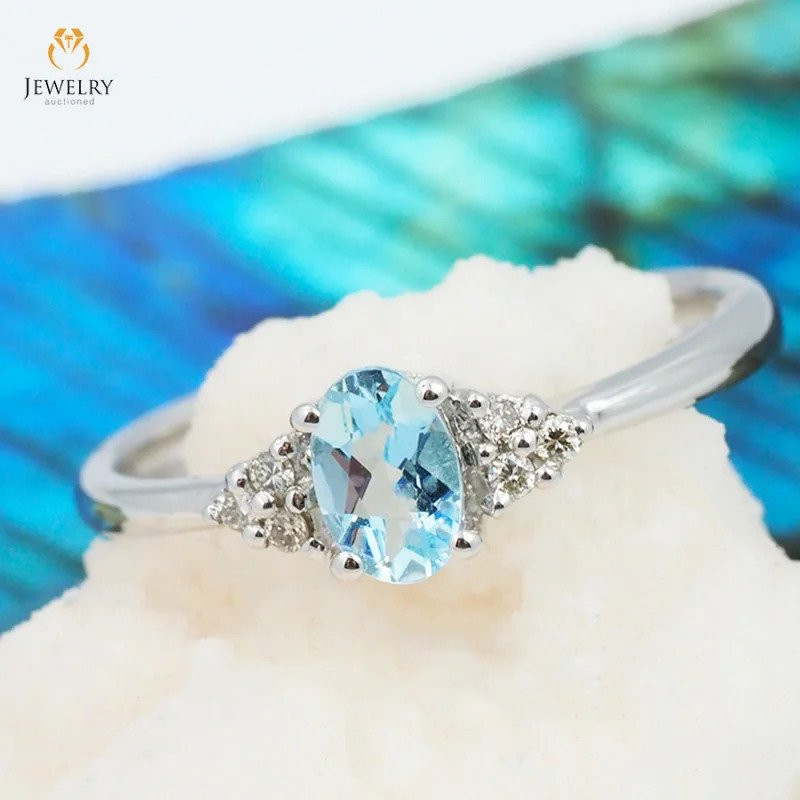
¿Qué piedra de nacimiento de marzo es la adecuada para ti?
¿Te tienta la suave y etérea aguamarina o la rica y terrosa piedra de sangre? Ambas piedras natales de marzo ofrecen valentía y sanación, a la vez que se combinan con las asociaciones del mes con los nuevos comienzos. En cualquier caso, ¡cualquier piedra en la joyería con piedras natales de marzo tiene un atractivo atemporal!
Buscar en el Gemstone Encyclopedia
Subastas relacionadas
Artículos relacionados
Las esmeraldas Gota de Aceite tienen una característica especial que aumenta su valor. Lea más sobre este raro tipo de esmeralda y descubra cómo aumenta su valor.
9th May 2018
El jade es una hermosa piedra que puede tener muchos colores, como verde, naranja o blanco. Aprende a probar el jade para comprobar su autenticidad.
9th May 2018
La cornalina es un mineral de calcedonia famoso por sus intensos colores naranjas. ¡Aprenda todo sobre el significado, la historia y las propiedades de la cornalina en esta práctica guía!
26th Feb 2021
últimos artículos
Las tallas de marfil de palma, también llamadas marfil vegetal, son una alternativa natural al marfil de elefante, extraído éticamente de la nuez de palma de la palmera sudamericana Phytelephas. ¡Aprenda todo sobre el marfil de palma en esta guía!
15th Jan 2026
Las piedras de flores de crisantemo son maravillas naturales que presentan un patrón floral de calcita blanca, celestita o andalucita sobre piedra caliza negra o lutita.
13th Jan 2026
La piedra solar reticulada arcoíris es una variedad de feldespato con tres magníficos efectos ópticos causados por la presencia de diversas inclusiones. Su vibrante colorido y su patrón reticular la convierten en una rara joya de colección.
12th Jan 2026
Categorías de artículos
How To's is where you will find helpful articles from gem Rock Auctions on how to cut gemstones, select gemstones and buy gemstones.
9 Artículos




